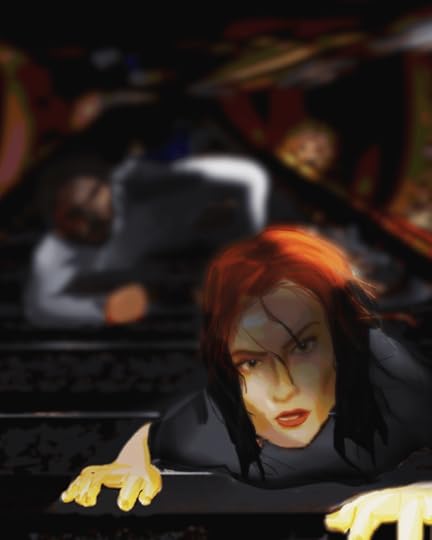Exploring Foils as Storytelling Tools
When I first started writing the Industrialized series, the creation of this vast world started with one specific character: Saida Merymut. Though she’s a minor character in the primary duology, she is the main character in my current WIP – a dystopian romance that explores the intersection of love and war. All’s fair in love and war, they say – but what if you have to explore both realities at once? Truth be told, that was the original concept behind the story, but I realized Saida’s arc was too clean for the concept I wanted to bring to life and the commentary I wanted to infuse – I needed someone grittier, less moral, to tell that tale. So her foil became the main character and narrator of Part One: Experiment and Part Two: Execution.
In fiction, we often fall in love with characters not just for who they are, but for what they reveal in contrast to others. Foils – in this article, I’ll be specifically exploring characters (rather than settings and objects or subplots) who highlight the traits, values, or arcs of another through contrast – are among the most powerful tools a writer can use. Foils sharpen emotion, explore themes, and give a story its heartbeat through subtle comparison.
While we’ll be exploring what foils are and the purpose they serve, I’ll specifically be drawing inspiration from the potent character pairings of Saida and Captain versus Kristina and Titus — two duos who mirror and oppose each other with surgical precision, if I may say so. Through them, we see how foil relationships can do more than reflect; they expose. Let’s dive into how foils can be used to craft a story. Shall we?
 Crafting Foils: It’s Not Just Opposites
Crafting Foils: It’s Not Just OppositesIt’s important to note that a foil doesn’t need to be an enemy. That’s what we have antagonists for, though they can certainly serve as foils if they’re intentionally crafted as such. Oftentimes, the best foils often share a deep connection with the character they contrast. Similar background, shared goals, or parallel roles all strengthen the foil effect.
Saida and Kristina, for example, both come from structured, wealthy, high-expectation worlds. Captain and Titus are both male leaders in complex moral situations, and both were raised in repressive environments. The contrast between these characters is so much more than just “good guy vs. bad guy” – it’s how they respond to the same pressures.
For us writers, that means we’ll have to dig beyond simple binaries to bring a story to life. Think of characters like Frodo and Gollum. When two characters are similar in context, the more meaningful their differences become. A good foil doesn’t have to be loud. It just has to be deliberate.
Most recently, I’ve been rewatching Buffy the Vampire Slayer. In Season 5, I’ve noticed that Ben acts as something of a foil to Buffy – both are seemingly normal humans who had supernatural circumstance thrust upon them. When Ben starts to crack and begins negotiating with Glory, the slow creep of wickedness into his character arc serves as a bold contrast to Buffy’s steadfast dedication to justice… And, to a degree, it also hints at some unraveling we could possibly see in the future. (No spoilers here, but everyone should watch Buffy. The show absolutely has its pitfalls and content warnings, but it’s a masterclass in solid storytelling.)
Foils as Emotional BlueprintsAt their core, foils typically emphasize personality traits. But when used to illuminate emotional stakes, they unlock a deeper kind of storytelling. Think about it… how do you show the difference between healthy love and toxic obsession? Through contrast!
In the Industrialized series and especially in my upcoming novel, Saida and Captain’s love is built on consent, communication, and friendship. Their relationship is all about comfort and growth, showing how true intimacy respects autonomy. Captain never seeks to define Saida’s future – in fact, he supports her in shaping it, asking only how he can walk alongside her. In contrast, the magnum opus of the relationship between Kristina and Titus is manipulation, as both, to a degree, write off the imbalance of power as fate. Titus molds Kristina’s life to fit his vision, erasing her agency in the process. His version of “love” becomes a form of control.

For writers, this kind of foil work doesn’t just raise stakes – it gives the reader a measuring stick. (And I will always recommend putting the reader first when you’re writing.) One couple makes the other’s flaws more visible. We know Captain is trustworthy because we see how Titus behaves. We ache for Kristina because we see what Saida has. The reader internalizes values without the author needing to preach.
On an even deeper level, your readers will pick up on the nuanced critiques you offer through your characters with the infusion of foils. In the alpha phases of Part Two, one reader commented on the shock of seeing Kristina sympathize with those who were against environmental reforms. This reader was a friend I know personally in real life, so they certainly knew she wasn’t echoing my beliefs. But surrounded by and contrasted against a much more morally sound cast, her beliefs especially stood out as problematic. You can physically see how she almost gets it, but not quite. Compared against her friendship with Saida, though, there’s almost a seed of hope that blooms when we see her problematic nature… You can tell she wants to be better. Life’s a journey for everyone, and foils help your world feel lived in and authentic without being preachy.
How Foils Echo Agency and ChoiceAs demonstrated by Kristina’s problematic beliefs, having a strong foil in your story can highlight philosophical or thematic tensions. Kristina and Saida serve as a common and effective example of exploring two characters with similar backgrounds and different responses to their world. This technique lets your readers ask, “What makes someone choose differently?” It’s a tool for reflection, essentially, that can elevate your story beyond a tall tale into something more introspective.
 Photo by Yannick Béra
Photo by Yannick BéraIn many ancient myths, like Isis and the Seven Scorpions, introspection and the weight of themes is often what led to stories being preserved. Do we know if people really believed that seven giant scorpions followed the goddess around as she sought shelter? Well, no, we can’t necessarily comment on individual beliefs. But we can say that something about the themes of being kind to those in need, the contrast between death and life, and forgiveness resonated with people. It made them think and reflect. The same power can be captured in our modern-day masterpieces.
In Industrialized, Saida learns to exercise her agency in small and large ways, while Kristina is never given the tools to imagine life outside of what she’s been groomed to believe. Where Saida fights for a future she defines herself, Kristina is coerced into serving someone else’s. And that’s not just in the guise of Titus, who prepares her to serve in his rebellion – we see it in the form of her accepting societal judgment, that Ralph doesn’t want his fellow churchgoers to know that she’s a common worker, that Lavinia had to give her child up and accept help from T.I. to survive. Kristina accepts because she’s been coerced. Saida pulled her sword out and hand-carved her path, and she kept it handy to threaten anyone who might try to sway her.
This divergence becomes essential in theme-driven fiction. Want to talk about freedom? Build a foil who never got it. Want to explore identity? Let two characters define themselves in opposite ways. Writers can use foils to explore philosophical questions. And honestly? We should.
Readers don’t need to consciously recognize this trick to feel its power. The contrast lodges in their hearts. It lingers, just like the ancient myths that time has preserved.
What Foils Say About Thematic StakesWe’ve talked enough about the girlies in Industrialized. Let’s talk about the men!
Another powerful and common application of foils lies in character arcs. While some characters exist to change, others exist to show what happens when someone doesn’t.
Captain is a character who changes with his love. His relationship with Saida is a space for evolution, vulnerability, and becoming. Titus, on the other hand, never truly transforms. His affection for Kristina grows, yes, but it is still rooted in the same possessiveness that marked his control. And critically, the story denies him redemption. Sure, it ends with him and Kristina being cordial, but he’s still clearly on a path to improve. He may get there one day, but he may not. With where the story leaves him, readers only know that he hasn’t been redeemed.
This contrast sends a message: not all change is equal. Not all love redeems. Writers should think of foils as a litmus test for the moral engine of their story. What gets forgiven? What doesn’t? A foil can make sure the consequences feel earned.
In practical terms, writers can ask themselves: Is there a character who fails at what the hero succeeds at? Is there someone who chooses the opposite path? Their presence will help clarify what you want the story to say.
And with Captain and Titus? Both men were raised in cult environments, and both carry some trauma as a result. Captain leaves and establishes his crew to oversee the Vagabond, but Titus stays, grows more entrenched, and expands Tarm Industries. Captain feels guilty when he and Saida slowly find love, as he recognizes that it’s not fair to favor one member of his crew over others. Titus and Kristina also slowly fall in love, and though Titus knows it’s wrong, he pursues it – and admits that he’s being selfish. Captain is stoic but conversational. Titus is theatrical and a trickle-truther. Both are clear products of their upbringings, but Titus is a very clear example of what happens when one doesn’t confront their trauma. Captain makes that story so much more resonant, and Titus’s story makes Captain’s feel all the more powerful and respectable.
Foils Elevate StoriesAll in all, foils work because they deepen our readers’ understanding. They don’t just tell us who a character is – they show us in bold relief. In the world of Saida and Captain, their choices shine brighter because of the shadows cast by Kristina and Titus. In one pair, love is mutual and freeing; in the other, it’s a trap disguised as destiny.
The next time you’re designing your cast of characters, ask yourself: Who is the mirror? Who is the shadow? Who fails where my protagonist grows?
Because in the end, we don’t just want to see our heroes – we want to understand them. Foils forge clarity. When done right, foils don’t just support your hero’s journey. They define it.
The post Exploring Foils as Storytelling Tools first appeared on Nikki Elizabeth.



